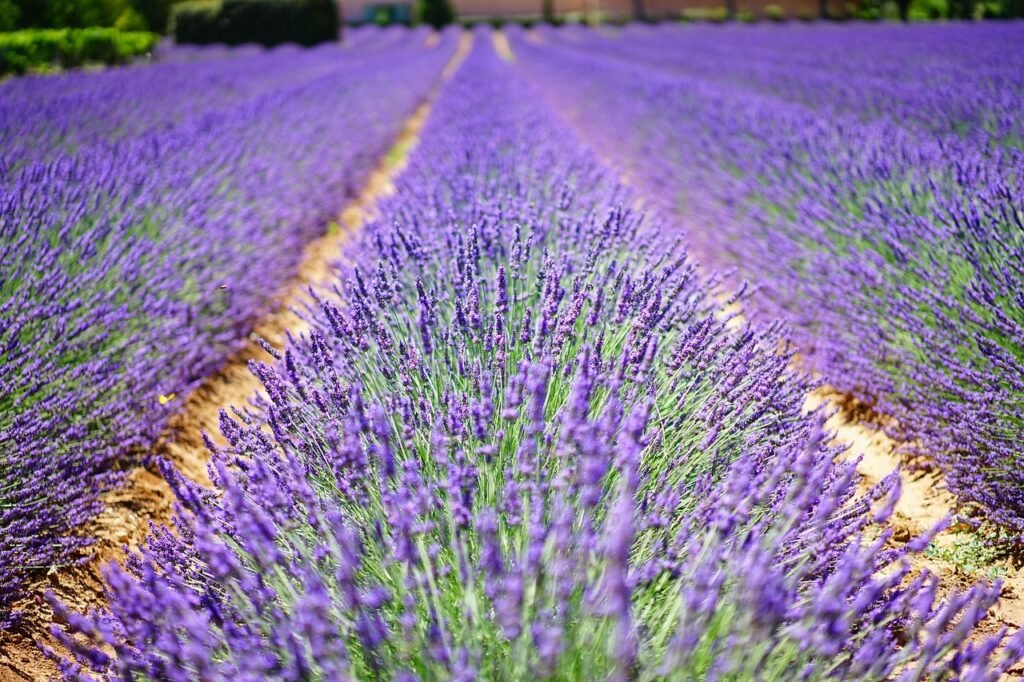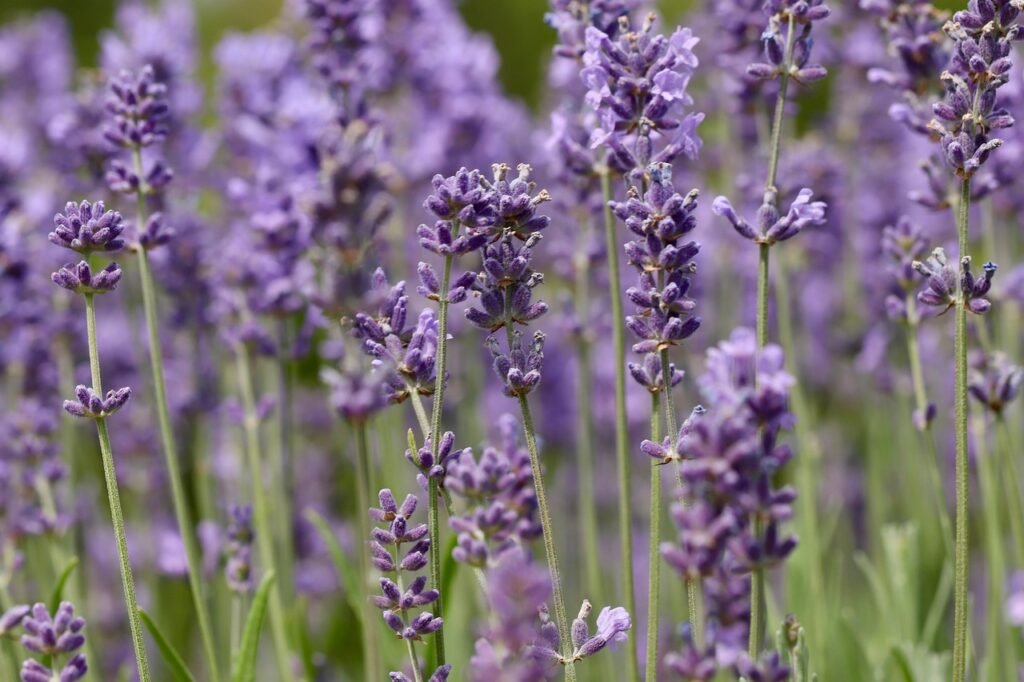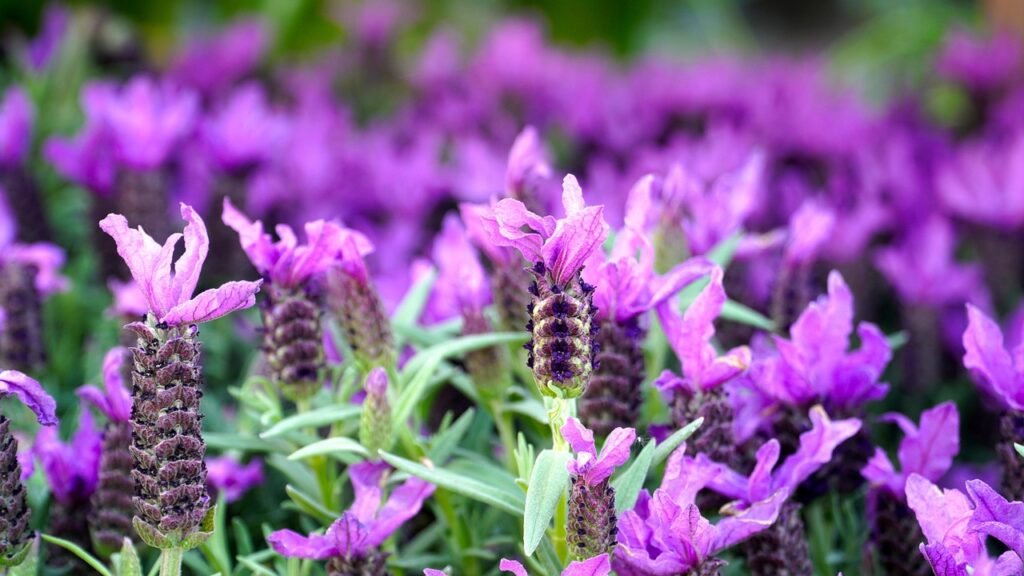

1. Introduction
Lavender is a beloved herb, cherished for its fragrant flowers, calming scent, and ornamental appeal. This guide provides comprehensive information on growing and caring for lavender plants, including tips on cultivation, maintenance, and uses.
2. Plant Profile
- Botanical Name: Lavandula spp.
- Common Names: Lavender
- Family: Lamiaceae
- USDA Zone: USDA zones 5-9
- Origin: Mediterranean region
3. Description
Lavender is a woody perennial herb with narrow, aromatic leaves and spikes of fragrant flowers. The leaves come in various shapes, sizes, and colors, ranging from green and blue-green to pink, purple, and red.
Lavender produces colorful, bell-shaped flowers on tall stalks, typically in shades of pink, purple, and blue. These flowers are highly attractive to pollinators such as bees and butterflies.

4. Growing Conditions
Sunlight
Lavender thrives in full sun and requires at least 6-8 hours of sunlight per day for optimal growth and flowering.
Temperature
Lavender prefers warm temperatures between 65°F to 80°F (18°C to 27°C). Protect lavender plants from temperatures below 50°F (10°C) as they are not frost-tolerant.
Soil
Well-draining soil is essential for lavender. Use a cactus or succulent potting mix or amend regular potting soil with sand or perlite to improve drainage.
Watering
Allow the soil to dry out between waterings, then water thoroughly until water drains from the bottom of the pot. Lavender is susceptible to root rot, so avoid overwatering.

Humidity
Lavender is adaptable to low humidity levels but may benefit from occasional misting in dry environments.
5. Winter Care
In colder climates, protect lavender from frost and freezing temperatures. Bring plants indoors or provide frost protection if grown outdoors.
During winter, reduce watering as growth slows, but ensure the soil does not dry out completely.
6. Planting Lavender
- Plant lavender in containers with drainage holes or in well-draining soil in the garden.
- Ensure the plant’s crown is slightly above the soil level to prevent rotting.
- Space lavender plants at least 12-18 inches apart to allow airflow and prevent overcrowding.

7. Care and Maintenance
Watering
Water lavender sparingly, allowing the soil to dry out between waterings. Reduce watering during the winter months when growth slows.
Fertilizing
Feed lavender with a balanced, water-soluble fertilizer diluted to half-strength once a month during the growing season (spring and summer).
Pruning
Prune lavender plants regularly to maintain their shape and encourage bushy growth. Trim back spent flower spikes and prune leggy growth in early spring.

Pest and Disease Control
Monitor for pests such as aphids, spider mites, and root rot. Treat infestations promptly with insecticidal soap or neem oil. Ensure good air circulation around the plants to reduce the risk of fungal diseases.
8. Propagation
Lavender can be propagated from seeds, cuttings, or layering.
- To propagate from cuttings, take 4-6 inch stem cuttings from healthy, non-flowering shoots in spring or early summer. Remove the lower leaves and plant the cutting in well-draining soil or rooting medium.
9. Flowering
Lavender typically blooms in late spring to early summer, producing clusters of bell-shaped flowers on tall stalks.
Deadheading spent flowers encourages continued blooming and prevents seed production.
10. Uses of Lavender
Ornamental
Lavender is prized for its ornamental value in gardens, borders, and containers. It adds fragrance, color, and texture to landscaping and attracts pollinators such as bees and butterflies.
Medicinal
Lavender has medicinal properties and is commonly used in aromatherapy, herbal remedies, and skincare products for its calming and soothing effects.
Culinary
Culinary lavender flowers and leaves can be used to flavor baked goods, beverages, and savory dishes. Its distinct fragrance and taste add a unique touch to many recipes.
11. Using Lavender in the Garden
A. Companion Plants
Lavender attracts beneficial insects such as bees and butterflies to the garden. It pairs well with other Mediterranean herbs like rosemary, thyme, and sage.
Avoid planting lavender near plants that require frequent watering or have high moisture needs, as this can lead to root rot and other issues.
B. Garden Design Ideas
- Using Lavender as a Focal Point: Plant lavender as a focal point in garden beds, borders, or containers. Pair it with complementary plants for a striking display.
- Using Lavender in Mass Plantings: Create stunning mass plantings of lavender for a dramatic effect. Plant it in drifts or rows for maximum impact.
C. Landscaping Ideas
- Using Lavender in Naturalistic Plantings: Incorporate lavender into naturalistic garden settings, rockeries, or Mediterranean-inspired landscapes.
- Using Lavender in Formal Plantings: Lavender adds structure and fragrance to formal garden designs, such as knot gardens or parterres.
12. Conclusion
Lavender is a versatile and attractive herb that adds beauty, fragrance, and utility to gardens and landscapes. With proper care and maintenance, lavender plants will reward gardeners with years of enjoyment and practical use.
